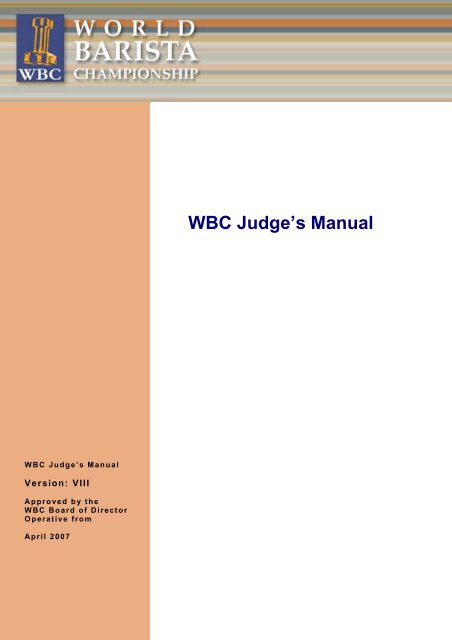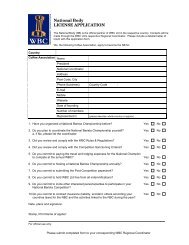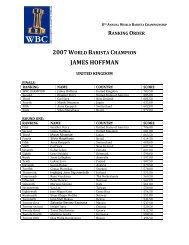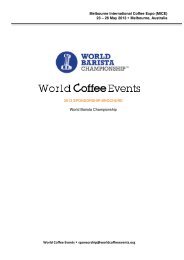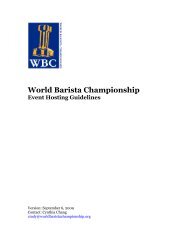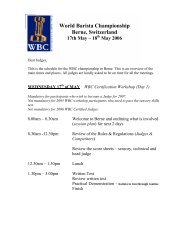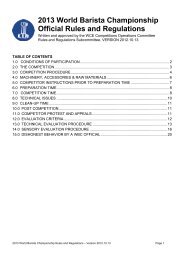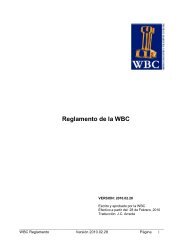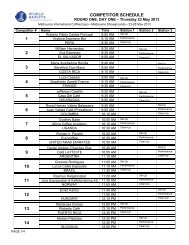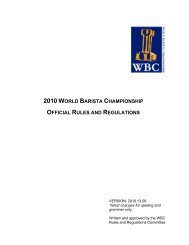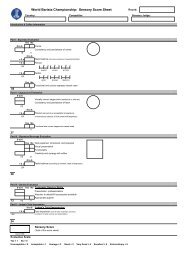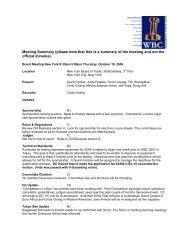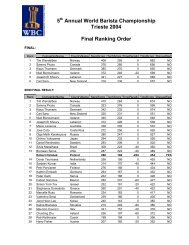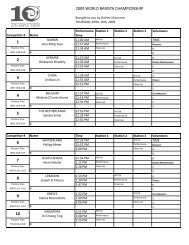WBC Judge's Manual - World Barista Championship
WBC Judge's Manual - World Barista Championship
WBC Judge's Manual - World Barista Championship
Create successful ePaper yourself
Turn your PDF publications into a flip-book with our unique Google optimized e-Paper software.
th<strong>WBC</strong> Judge’s <strong>Manual</strong><strong>WBC</strong> Judge’s <strong>Manual</strong>Version: VIIIApproved by the<strong>WBC</strong> Board of DirectorOperative fromApril 2007<strong>WBC</strong> Judge <strong>Manual</strong>
TABLE OF CONTENT1 PREFACE ........................................................................................................................................ 11.1 ELIGIBILITY OF <strong>WBC</strong> JUDGES........................................................................................................... 11.1.1 <strong>WBC</strong> Judges ..................................................................................................................................... 11.2 <strong>WBC</strong> RECOMMENDED QUALIFICATIONS ....................................................................................... 11.3 THE GOALS FOR THE <strong>WBC</strong> JUDGES CERTIFICATION PROGRAM ......................................... 11.4 WHO CAN APPROVE JUDGES ........................................................................................................... 11.5 PROTESTS AND APPEALS.................................................................................................................. 12 PRE-COMPETITION........................................................................................................................ 22.1 THE SCORE SHEETS ............................................................................................................................ 22.2 THE GOALS AND PURPOSE OF THE JUDGES .............................................................................. 22.3 WHAT IS THE JUDGES LOOKING FOR IN A WORLD CHAMPION?.......................................... 22.4 MAIN TASKS FOR <strong>WBC</strong> CERTIFIED JUDGES ................................................................................ 22.5 WHAT THE JUDGES SHALL EXPECT FROM THE COMPETITORS........................................... 32.6 MANDATORY JUDGES’ MEETINGS .................................................................................................. 33 THE COMPETITION PERIOD ......................................................................................................... 43.1 JUDGE PROTOCOL DURING COMPETITION.................................................................................. 43.1.1 Competition start............................................................................................................................... 43.1.2 During taste evaluation.................................................................................................................... 43.1.3 After Competition Period (5 min calibration)................................................................................. 43.1.4 Other “do’s and don’ts” .................................................................................................................... 53.1.5 Scorekeeping .................................................................................................................................... 53.2 COMMUNICATION WITH THE PUBLIC OR MEDIA......................................................................... 53.3 TROUBLE SHOOTING........................................................................................................................... 53.3.1 The competitor spills or does not prepare a beverage ............................................................... 53.3.2 The judges are not on time ............................................................................................................. 53.3.3 The competitor violates the <strong>WBC</strong> rule and regulation................................................................. 53.3.4 If the signature beverage does not include espresso ................................................................. 64 TECHNICAL EVALUATION PROCEDURE.................................................................................... 74.1 EVALUATION SCALE ............................................................................................................................ 74.2 TECHNICAL SCORE SHEET – PART I............................................................................................... 74.2.1 Clean working area at start-up/Clean cloths ................................................................................ 74.2.1.1 Additional aspects ........................................................................................................................ 74.3 TECHNICAL SKILLS ESPRESSO – PART II..................................................................................... 84.3.1 Flushes the group head................................................................................................................... 84.3.2 Dry/clean filter basket before dosing ............................................................................................. 8<strong>WBC</strong> Judge <strong>Manual</strong>Table of Content
4.3.3 Acceptable spill/waste when dosing/grinding............................................................................... 84.3.4 Consistent dosing and tamping ...................................................................................................... 84.3.5 Clean porta filters before insert ...................................................................................................... 94.3.6 Immediate insert and brewing ........................................................................................................ 94.3.7 Extraction time (20-30 seconds)..................................................................................................... 94.4 TECHNICAL SKILLS CAPPUCCINO – MILK FROTHING – PART III ........................................... 94.4.1 Visually correct espresso base....................................................................................................... 94.4.2 Empty/clean pitcher at start ............................................................................................................ 94.4.3 Purges the steam wand before steaming ..................................................................................... 94.4.4 Cleans steam wand after steaming ............................................................................................. 104.4.5 Purges the steam wand after steaming....................................................................................... 104.4.6 Clean pitcher/acceptable milk waste at end ............................................................................... 104.5 TECHNICAL SKILLS SIGNATURE BEVERAGE – PART IV ........................................................ 104.6 TECHNICAL – PART V ................................................................................................................. 104.6.1 Understands grinder....................................................................................................................... 104.6.2 Cleans porta filter spouts/Avoided placing spouts in dosing chamber ................................... 104.7 STATION EVALUATION AT END – PART VI .................................................................................. 114.7.1 Clean working area at end ............................................................................................................ 114.7.2 General hygiene throughout presentation .................................................................................. 114.7.3 Proper usage of cloths................................................................................................................... 115 EVALUATION PROCEDURE SENSORY ..................................................................................... 125.1 EVALUATION SCALE .......................................................................................................................... 125.2 ESPRESSO EVALUATION– PART I ................................................................................................. 125.2.1 Colour of crema .............................................................................................................................. 125.2.2 Consistency and persistence of crema ....................................................................................... 125.2.3 Taste balance.................................................................................................................................. 135.2.4 Tactile balance................................................................................................................................135.2.5 All 4 espressos served simultaneously ....................................................................................... 135.2.6 Correct espresso cups used ......................................................................................................... 135.2.7 Served with accessories................................................................................................................ 135.3 CAPPUCCINO EVALUATION – PART II .......................................................................................... 135.3.1 Visually correct cappuccino .......................................................................................................... 135.3.2 Consistency and persistence of foam ......................................................................................... 135.3.3 Taste balance.................................................................................................................................. 145.3.4 All 4 cappuccinos served simultaneously ................................................................................... 145.3.5 Correct cappuccino cups used ..................................................................................................... 145.3.6 Served with accessories................................................................................................................ 145.4 SIGNATURE BEVERAGE EVALUATION – PART III ..................................................................... 145.4.1 Well explained and presented ...................................................................................................... 155.4.2 Appealing look................................................................................................................................. 155.4.3 Creativity.......................................................................................................................................... 155.4.4 Taste balance.................................................................................................................................. 155.4.5 All 4 signature beverages served simultaneously ..................................................................... 155.5 BARISTA EVALUATION – PART IV.................................................................................................. 155.5.1 Presentation: Professionalism/Dedication/Passion................................................................... 165.5.2 Attention to details/All accessories available.............................................................................. 165.5.3 Appropriate apparel........................................................................................................................ 165.6 JUDGE’S TOTAL IMPRESSION – PART V......................................................................... 16<strong>WBC</strong> Judge <strong>Manual</strong>Table of Content
5.6.1 Judge’s Total Impression .............................................................................................................. 165.6.2 Time penalty.................................................................................................................................... 165.6.2 Final remarks................................................................................................................................... 166 HEAD JUDGE................................................................................................................................186.1 MAIN GUIDELINES FOR THE <strong>WBC</strong> HEAD JUDGE....................................................................... 186.2 PRE-COMPETITION ............................................................................................................................. 186.2.1 Judge meeting ................................................................................................................................186.3 COMPETITION PERIOD....................................................................................................................... 186.3.1 Before the competitor starts.......................................................................................................... 186.3.2 Competition time............................................................................................................................. 196.3.3 The judge 5 minute intermission .................................................................................................. 196.4 COMPETITION END ............................................................................................................................. 196.5 TROUBLE SHOOTING......................................................................................................................... 19<strong>WBC</strong> Judge <strong>Manual</strong>Table of Content
1 PREFACEThe <strong>World</strong> <strong>Barista</strong> <strong>Championship</strong> (<strong>WBC</strong>) Rules & Regulations Committee develops the standardfor <strong>WBC</strong> Certified Judges. All <strong>WBC</strong> judges are required to adhere to these standards. Judges areadvised to thoroughly review and understand the <strong>WBC</strong> Rules & Regulations, the score sheets andthe Judge Code of Conduct to ensure that they are familiar with the criteria. All <strong>WBC</strong> documentsmay be downloaded from the website: www.worldbaristachampionship.comThis manual provides an introduction to the regulations for <strong>WBC</strong> certified judges.1.1 ELIGIBILITY OF <strong>WBC</strong> JUDGES1.1.1 <strong>WBC</strong> JudgesA. Only experienced <strong>WBC</strong> approved and certified judges are allowed to judge in the <strong>World</strong><strong>Barista</strong> <strong>Championship</strong>.B. The Judge and Certification Committee (JCC) are responsible for the certification of <strong>WBC</strong>judges.C. JCC are responsible for selecting eligible judges for the <strong>WBC</strong>.D. The selection of judges shall be announced by the JCC at least three moths prior to theupcoming <strong>WBC</strong>. The selected judges will be announced on the website.www.worldbaristachampionship.com1.2 <strong>WBC</strong> RECOMMENDED QUALIFICATIONS1. The <strong>WBC</strong> recommends that applicants are committed to coffee quality, to the promotion of thebarista profession, and to coffee excellence.2. Previous experience as a judge in either national or international barista competitions isessential.3. Applicants should possess fundamental barista skills.4. Experience in cupping, tasting or judging in other taste related profession is essential.1.3 THE GOALS FOR THE <strong>WBC</strong> JUDGES CERTIFICATION PROGRAM1. To qualify judges for the <strong>WBC</strong> finals.2. To achieve a higher standard and consistency among <strong>WBC</strong> judges.3. To train <strong>WBC</strong> judges to become professionals within the <strong>WBC</strong> competition.4. To create an international pool of certified judges who can assist in national competitionsworldwide.1.4 WHO CAN APPROVE JUDGESThe Judge & Certification Committee (JCC) is the only body that certifies <strong>WBC</strong> judges. The JCCChairperson must approve each certification.1.5 PROTESTS AND APPEALSSee Chapter 5 of the <strong>WBC</strong> Rules and Regulations.<strong>WBC</strong> Judge <strong>Manual</strong> Version: VIII Page:1
2 PRE-COMPETITIONAll certified <strong>WBC</strong> judges must review the following prior to the certified calibration program.A. Have an in-depth knowledge of, and adhere to, the <strong>WBC</strong> rules and regulations.B. Have an in-depth knowledge of the competition area set-up and the competition flow.C. Have an in-depth knowledge of the Judge’s Evaluation <strong>Manual</strong> and the score sheets.D. Have a good understanding of various taste profiles in espresso blends, milk and otherrelated tastes.2.1 THE SCORE SHEETS1. There are three types of score sheets: Head Judge, Technical Judge, and Sensory Judge.2. Judges should understand all three score sheets.3. Judges should be fair and honest, always providing positive remarks on the score sheets.Judges must write clearly. (Remember that baristas will receive their score sheets after thecompetition.)2.2 THE GOALS AND PURPOSE OF THE JUDGES1. To know the <strong>WBC</strong> rules and regulations and the scoring method in detail.2. To support the barista profession and all <strong>WBC</strong> competitors.3. To promote speciality coffee and coffee excellence.4. To be neutral, fair and consistent when evaluating baristas.5. To select a worthy and highly professional <strong>World</strong> <strong>Barista</strong> Champion.2.3 WHAT IS THE JUDGES LOOKING FOR IN A WORLD CHAMPION?1. The judges are looking for a Champion who has a mastery of technical skills, craftsmanship,who has service and communication skills, and who is passionate about the baristaprofession.2. The judges are looking for a Champion who has a broad knowledge of coffee and serves highquality beverages.3. The judges are looking for a Champion who may serve as a role model and will be aninspiration to others.2.4 MAIN TASKS FOR <strong>WBC</strong> CERTIFIED JUDGES<strong>WBC</strong> judges are expected to assist the competitor to become better by:1. Supporting the competitor during the 15 minutes of competition time (and not making it moredifficult). Judges should maintain a low profile and allow the competitor to have a comfortableworking space.2. Participating in the competitor debriefing (score sheet review), at the end of competition, toreview opportunities and areas for improvement.3. Always respecting each competitor and his/her cultural background.4. Having knowledge of cultural differences in espresso preparation and presentation ofbeverages, but always evaluating the baristas according to the <strong>WBC</strong> Rules and Regulationsand the Judge’s <strong>Manual</strong>.5. Being accessible to the competitors after the competition for further comments.6. Always writing objective and respectful comments on the score sheets.<strong>WBC</strong> Judge <strong>Manual</strong> Version: VIII Page:2
2.5 WHAT THE JUDGES SHALL EXPECT FROM THE COMPETITORS1. Competitors will have a firm understanding of the <strong>WBC</strong> Rules & Regulations, <strong>WBC</strong>Competitor’s <strong>Manual</strong>, the <strong>WBC</strong> score sheets, and the Competitor Code of Conduct.2. Competitors will be in the competition area at least thirty minutes prior to their competitiontime.3. Presentations will be in accordance with the <strong>WBC</strong> Rules and Regulations.4. Competitors will perform within the competition time of 15 minutes. The competitor will havepoints deducted if their performance runs over 15 minutes. The competitor will be disqualifiedif the performance time exceeds 16 minutes.5. Competitors will have all small wares and accessories available.2.6 MANDATORY JUDGES’ MEETINGSA. All <strong>WBC</strong> judges must attend scheduled pre and post judges’ evaluation meeting.B. It is very important that the judges are on time and respectful of each other.C. If a judge does not attend a judges’ meeting, he/she may be removed from the judging team.D. Judges should always respect each other’s opinions and cultural differences.<strong>WBC</strong> Judge <strong>Manual</strong> Version: VIII Page:3
3 THE COMPETITION PERIOD3.1 JUDGE PROTOCOL DURING COMPETITIONA. In addition to the competing barista, the Master of Ceremonies, and the support staff, therewill be a panel of seven (7) judges in the competition area. Therefore, there are strict rulesfor judge’s behaviour. Any judge who is in violation of the rules and regulations may beremoved from the panel and the competition area.B. The Head Judge has the right of veto in all matters concerning the decorum of the judges.Due to the confined space, it will be necessary for all judges to work together. Judges musthave trust in one another and work discreetly and quietly as a team.‣ Remember that the Competitor is just one person – while the judging team isseven people and therefore very visible.3.1.1 Competition startJudges must be positive and respectful of the competitor at all times. Judges should welcomethe competitor when introduced. When the competitor presents him/herself to the judges, alljudges should listen, focus and relate only to the competitor.A. Communication between the judges while the competitor is speaking is NOT allowed.B. Communication between the judges during the competition time should minimal. It is notallowed, unless absolutely necessary or to clarify a point with the Head Judge.C. Discussion about drinks, the competitor’s technique or skills, presentation and otherelements of the performance is not allowed.3.1.2 During taste evaluationIt is important to remember that the audience, volunteers, organizers, and most importantly, thecompetitor, may all be focused on the judges during the drink evaluations. Any and allmovements and/or facial expressions that could be interpreted as either a positive or negativeshould be avoided.The following should be avoided:A. Making eye contact with anybody while tasting. Remember it is a normal human instinct tomake a facial expression during eye contact.B. Laughing during the taste evaluation.C. Making facial expressions while tasting.D. Doing anything that can be interpreted negatively by the competitor or the audience.E. Communicating audibly with other judges and/or sharing your evaluation with other judges.F. Communication with the competitor (unless answering a competitor’s question).G. Judges may communicate discreetly during the evaluation period; however, anycommunication must be minimal, quiet and done tactfully.H. All discussion, verification and questions directed to the head judge and/or other judgesshould take place backstage after the completion of the competitor’s performance.3.1.3 After Competition Period (5 min calibration)A. Ensure that you have completed all areas on the score sheet before handing it to the HeadJudge.B. If you need to correct an error, or change a score, clearly identify, correct, tick and circle,then initial nearby.C. Communication with members of the audience should not take place during a competitionperiod. The audience and/or a competitor can interpret this negatively.D. No mobile phones may be used during competition rounds.E. Judges must attend judge meetings pre- and post competition and attend theannouncement of the results.F. Judges must attend the competitor debriefing session (score sheet review) following thecompetition.<strong>WBC</strong> Judge <strong>Manual</strong> Version: VIII Page:4
3.1.4 Other “do’s and don’ts”A. Communication between judges is allowed, but must be done quietly and at an appropriatetime.B. Communication with the competitor is also allowed, but should be limited.C. Always make eye contact with the competitor when they are serving drinks.D. Always remember the psychological impact that a judge can have on a barista.E. Do not hand drinks to audience members after tasting.F. Only consume bland and neutral tasting food before judging (avoid strong and pungentfoods and flavours that will impact tasting abilities).G. Never eat while judging (unless instructed to do so by a competitor).H. Judges must refrain from communicating with a competitor before and during thecompetition. Other competitors and the attendees can view this as personal coaching.I. Even judges who are in the audience are still judges. Be mindful of behaviours andcomments as competitors are often also in the audience.J. Always use non-perfumed deodorant and never wear perfume, cologne or similar productswith strong aromas; these scents can interfere with the sensory evaluation.K. Smile and be friendly to competitors.3.1.5 ScorekeepingThe Scorekeepers will complete all multiplication, addition, and deduct points for any overtimepenalty. No multiplication or addition needs to be done by judges. Judges should complete allscore marks and turn in completed score sheets to the Head Judge who will hand off score sheetsto the Scorekeeper.3.2 COMMUNICATION WITH THE PUBLIC OR MEDIAThe JCC Chairperson is responsible for all official <strong>WBC</strong> communication to the media regarding thejudging of competitors. If you speak to the media as a judge, you must adhere to the followingguidelines:A. Be positive and supportive of the barista profession and the promotion of coffeeexcellence.B. Be neutral. Do not name a favourite competitor or beverage.C. In general, avoid discussing the performance of individual competitors or their beverages.Do not provide any information that could discredit a competitor (such as talking aboutmistakes).D. Judges represents and speaks on behalf of the <strong>WBC</strong>, therefore make sure one do so.3.3 TROUBLE SHOOTING3.3.1 The competitor spills or does not prepare a beverageIf one (or more) sensory judge(s) does not receive any required beverage, that judge (and onlythat judge) is unable to evaluate the beverage. The sensory judge will score zero points in alltaste sections (for that beverage) on the sensory score sheet.3.3.2 The judges are not on timeThe <strong>WBC</strong> Judge Certification Committee is responsible for having backup judges in case ajudge does not show up or is not on time. If a judge does not to show up for a scheduled judginground, the judge must provide a valid reason to the <strong>WBC</strong> Judging Committee Chair, the <strong>WBC</strong>Event Manager and the Head Judge. Information shall be given at least 30 minutes before thejudge’s start time. The JCC Chairperson and the Head Judge will be responsible forimmediately replacing the judge.If a judge does not show up and does not give any valid reason to the JC Chair, Event Managerand/or the Head Judge, this judge will be exempt for future <strong>WBC</strong> judging.3.3.3 The competitor violates the <strong>WBC</strong> rule and regulationIt is the Head Judge’s responsibility to ensure that all competitors adhere to the <strong>WBC</strong> Rules andRegulations. The Head Judge will make a determination if a competitor violates a rule or<strong>WBC</strong> Judge <strong>Manual</strong> Version: VIII Page:5
egulation. If it’s a serious violation, it’s the Head Judge has the ability to disqualify thecompetitor.If the barista does not agree with the decision made by the Head Judge, the competitor mayfollow the protest procedures in chapter 5 of the <strong>WBC</strong> Rules and Regulation.3.3.4 If the signature beverage does not include espressoThe judge will score zero in all taste and presentation scores under signature evaluationSensory Score Sheet - Part IV. In addition, if espresso is not produced during the competitiontime, the technical judges will also score zero points on the Technical Score Sheet - Part IV.<strong>WBC</strong> Judge <strong>Manual</strong> Version: VIII Page:6
4 TECHNICAL EVALUATION PROCEDUREThe following is an explanation of the technical score sheet. Seven judges will evaluate eachcompetitor, including one head judge, two technical judges, and four sensory judges. The headjudge’s points are not included in the competitors total score. The two technical score sheets will beaveraged together for a single technical score. The technical score will then be added to each ofthe four sensory score sheets. The competitors final score will be comprised of the total of all foursensory score sheets.4.1 EVALUATION SCALEThe following is an explanation of the score sheet. It is best to review this while also looking at ascore sheet - technical and sensory. The score sheets are available atwww.worldbaristachampionship.comThe evaluation scale is the same for both technical and sensory judges.There are two types of scores: the Yes/No score, and the Zero to Six score.Yes = 1 No = 0Unacceptable = 0 Acceptable = 1 Average = 2 Good = 3 Very Good = 4 Excellent = 5 Extraordinary = 6Yes/No ScoreThe barista receives one point for a score of ‘Yes’ on this item, and zero points if ‘No.”Zero to Six ScoreWith the zero to six score, it is acceptable to use half point increments between 1.0 and 6. The halfpoints are written using a decimal point (not a fraction). For example 1.5, 2.5, 3.5…The lowest score with value is 1. (The score of 0.5 may not be used.)A score of Zero is used when something is totally unacceptable.The <strong>WBC</strong> Rules and Regulations state that a competitor is not allowed to change anything on thecompetition machines (such as the dispersion screen, spout, gasket and/or the portafilter). At thestart of competition, the technical judges will verify that the equipment is in accordance with <strong>WBC</strong>guidelines.4.2 TECHNICAL SCORE SHEET – PART IPart I - Station Evaluation At Start-UpCompetition Area 0 to 6Clean working area at start-up/Clean cloths/6 64.2.1 Clean working area at start-up/Clean clothsIt is permissible to have a small amount of coffee grounds around the grinder. The barista isallowed to work, therefore we do not score zero due to some coffee around the grinder.The cleanliness of the area should be evaluated on a scale between one and six. If the area isquite messy, a score of 1 can be given. It can be difficult to differentiate between a score of fourand five. If the overall impression is very good, the barista should be credited.4.2.1.1 Additional aspectsA. Evaluate the competitor’s ability to organize the items in the competition area in apractical and efficient way. If the competitor is organized, he/she should be given credit,and points should be given in the three to five range.<strong>WBC</strong> Judge <strong>Manual</strong> Version: VIII Page:7
B. It is possible for a competitor to over prepare. (I.e. cappuccino milk already in thesteaming pitchers, ingredients in the blender, ingredients in the glasses for the signaturebeverage). Over-preparation should be marked down. Competitors are encouraged to doall drink preparation during the performance time. If a competitor is pre-preparingsignature beverage ingredients, the competitor should not receive a score higher than oneor two at start-up.C. A minimum of three cloths should be available at the start of the performance time. Thecloths need to be clean and have a purpose. (I.e. one for milk spills, one for dryingbaskets, one for wiping steam wand.)D. The cups should be warm. (“Warm” is a relative term.) The barista should warm cupsduring the preparation time – cups should be placed on the machine top, preferably onthe boiler side. The following is not acceptable in the performance timei. Cups placed on the work station at start-upii. Cups in a basin with water at start-up4.3 TECHNICAL SKILLS ESPRESSO – PART IINote: The technical skills standards section is the same for all 3 beverages. (The technical scoresheet are the same in Part II, III and IV, with the addition of “visually correct espresso base” includedin the cappuccino and signature beverage evaluation.)Part II - Espresso EvaluationTechnical SkillsFlushes the group headDry/clean filter basket before dosingAcceptable spill/waste when dosing/grindingConsistent dosing and tampingCleans porta filters (before insert)Immediate insert and brewingExtraction time (20-30 seconds)0 to6 Yes No/12 /5 174.3.1 Flushes the group headThe barista must flush the group head prior to each extraction. (Some baristas will flush the grouphead just before inserting the portafilter; others flush the group upon removal.) If the group headwas flushed prior to the extraction of the served beverages, mark “Yes.”4.3.2 Dry/clean filter basket before dosingIf the filter basket was dried and cleaned prior to dosing the coffee, mark “Yes.”4.3.3 Acceptable spill/waste when dosing/grindingSpill/waste is ground coffee that was not used during the competition/performance time. (Thisincludes coffee that was levelled into the dosing chamber, into the knock box, onto the table, intothe garbage, onto the floor, etc.) Only evaluate spill/waste for espresso that is used/served. (Wastecreated by espresso that is not served does not count towards a barista’s waste.) Acceptablespill/waste is up to five grams of unused coffee per beverage category. In order to earn maximumscore, the waste should not exceed one gram of unused coffee per beverage category. Wastingmore than five grams of coffee per beverage category should result in a score of zero.4.3.4 Consistent dosing and tampingThere are different methods for dosing coffee. Consider shot volume and shot times in thisevaluation. (Does the method achieve the objective of 25 – 35 mls (30 mls +/- 5 mls) of extractedcoffee in 20-30 seconds extraction time.)?<strong>WBC</strong> Judge <strong>Manual</strong> Version: VIII Page:8
4.4.4 Cleans steam wand after steamingThe steam wand should be wiped clean with a dedicated bar towel.4.4.5 Purges the steam wand after steamingThe barista should purge steam wand after steaming milk.4.4.6 Clean pitcher/acceptable milk waste at endThe pitcher should be mostly empty after the cappuccinos have been prepared. Acceptable wasteis no more than 10 cl/ 3 oz. per steam pitcher.4.5 TECHNICAL SKILLS SIGNATURE BEVERAGE – PART IVPLEASE NOTEThe evaluations areas are the same as under the Cappuccino Evaluation – Technical skills. (Howeverthere is no milk evaluation.)4.6 TECHNICAL – PART VPart V - Technical EvaluationTechnical SkillsUnderstands grinderClean porta filter spouts/Avoided placing spouts in dozer chamber0 to6 Yes No/6 /1 74.6.1 Understands grinderA. Technical judges need to understand grinder operation, grinder management, dosing andtamping skills, and extraction.B. The barista should display an understanding of how to use the grinder – in both the operationand the management of coffee in and through the grinder. The barista should have adjustedthe grind during prep time. <strong>Barista</strong> should be grinding coffee for each shot or set of shots.C. The barista is trying to achieve a 20-30 second extraction time and is pouring 25-35 mls (30mls +/- 5 ml). Regardless of which dosing method is used, a consistent dosing method withineach drink set should be demonstrated. Cultural differences must be considered.D. The barista should create level tamps using a consistent method. Shot times and shot qualitywill also demonstrate the barista’s tamping skills.E. The technical judges are encouraged to inspect the spent puck of coffee inside the portafilterand relate the state of the puck to the barista’s understanding of grinder and consistency ofdosing and tamping skills. Judges will look for: levelness of tamp, indications of channeling orholes, excessively wet or dry puck, consistency of pucks (in groups of shots). (Note: somebaristas may not leave both/all pucks in the machine for judges to inspect and can not bemarked down for this.)F. Technical judges should stay aware of barista movement and not interfere with the baristaduring the performance.G. Please note: Any mess created by the technical judge (such as while checking the portafilteror grinder) needs to be cleaned up by the judge.4.6.2 Cleans porta filter spouts/Avoided placing spouts in dosing chamber<strong>WBC</strong> Judge <strong>Manual</strong> Version: VIII Page:10
A. The barista needs to remove any water or grounds on portafilter spouts by cleaning thespouts. Rinsing, using a towel, and wiping with fingers are all acceptable methods forachieving clean spouts.B. During leveling, the barista should not place porta filter spouts directly over the dosingchamber. (This could allow water to contaminate the dosing chamber.)4.7 STATION EVALUATION AT END – PART VIPart VI - Station Evaluation At EndCompetition AreaClean working area at endGeneral hygiene throughout presentationProper usage of cloths0 to6/6 /2 84.7.1 Clean working area at endIt is permissible to have a small amount of coffee grounds around the grinder. The barista isallowed to work; therefore we do not score a zero due to some coffee around the grinder. Thecleanliness of the area should be evaluated on a scale between zero to six. Cleaning while workingwill help the barista’s score, or taking time at the end of drink preparation to clean the station.4.7.2 General hygiene throughout presentationThe hygienic aspect is reflected in the entire presentation. In order have a “No” in this area; thebarista would need to do something unhygienic, such as:• Using a non-dedicated cloth to clean a steam wand (using it for some other purpose, thenusing it to clean a steam wand).• Doing something that is not sanitary or food safe with a towel (touching it to face, mouth,etc.).• Using a cloth once it has touched the floor or dropped.4.7.3 Proper usage of clothsWhen the presentation starts, the barista needs to have a minimum of three cloths available. (Acloth on the barista’s apron or pocket is included in this count.) All of the cloths should have apurpose. The barista should use one dedicated cloth for cleaning the steam wand, one forcleaning/drying the portafilter baskets and one for cleaning the workstation.<strong>WBC</strong> Judge <strong>Manual</strong> Version: VIII Page:11
5 EVALUATION PROCEDURE SENSORYThe following is an explanation of the sensory score sheets. Seven judges will evaluate eachcompetitor, including one head judge, two technical judges, and four sensory judges. The headjudge’s points are not included in the competitors total score. The two technical score sheets will beaveraged together for a single technical score. The technical score will then be added to all foursensory score sheets. The competitors final score will be comprised of the total of all four sensoryscore sheets.5.1 EVALUATION SCALEThe following is an explanation of the scoring sheet. It’s advisable to review this document withsamples of the score sheet. The score sheets are available atwww.worldbaristachampionship.comThe evaluation scale is the same for both technical and sensory judges.Yes = 1 No = 0Unacceptable = 0 Acceptable = 1 Average = 2 Good = 3 Very Good = 4 Excellent = 5 Extraordinary = 6(See explanation of evaluation scale under EVALUATION PROCEDURE TECHNICAL.)5.2 ESPRESSO EVALUATION– PART IPart I - Espresso EvaluationTaste Evaluation of Espresso 0 to 6Color of crema (hazelnut, dark brown, reddish reflection)Consistency and persistence of crema/120 to 6Taste balance (harmonious balance of sweet/acidic/bitter) x 4 =Tactile balance (full bodied, round, smooth) x 4 =/48Beverage Presentation Yes NoAll 4 espressos served simultaneouslyCorrect espresso cups usedServed with accessories (spoon, sugar, napkin and water)/3 635.2.1 Colour of cremaThe color of crema should be hazelnut, dark brown and/or have a reddish reflection. Crema that ispale or not present is unacceptable, and should result in zero points.5.2.2 Consistency and persistence of cremaThe crema should be dense and smooth. The crema should be long lasting with no center breakup.Crema must be present when espresso is served. Judges may drag a demitasse spoonthrough crema to test its recovery.Note: Evaluation of Color and Consistency of crema needs to be done QUICKLY. The tastebalance is the most important score, and judges must be sure to taste espresso quickly while it isfresh.<strong>WBC</strong> Judge <strong>Manual</strong> Version: VIII Page:12
5.2.3 Taste balanceThere should be a correlation between coffee beans used in the espresso and its taste profile. Anespresso will score high if is has a harmonious balance between sweetness, acidity and bitterness.It is NOT required that ALL of these elements are present to receive high marks. Keep in mind thata barista might use a single origin coffee and therefore the coffee may lack one of the threeattributes. The coffee may still be balanced and score highly in taste balance. Judges should listento any explanation given by the barista and look for taste that matches the barista’s explanation.5.2.4 Tactile balanceThe tactile balance of the espresso should be full bodied, round and smooth. This score relates tothe “mouthfeel” of the espresso. The judge’s perception of the espresso’s viscosity.5.2.5 All 4 espressos served simultaneouslyAll of the four espressos should arrive at the judge’s table at the same time.5.2.6 Correct espresso cups usedEspresso needs to be served in a two-to-three-ounce (60 to 90 ml.) cup with a handle.5.2.7 Served with accessoriesThe espresso should be served with a spoon, sugar, napkin, and water. All of these items must bepresent for the barista to receive a “Yes” score. If one (or more) item is missing at the time theespresso is served, mark “No.”5.3 CAPPUCCINO EVALUATION – PART IIPart II - Cappuccino EvaluationTaste Evaluation of Cappuccino 0 to 6Visually correct cappuccino (traditional or latte art)Consistency and persistence of foam/120 to 6Taste balance (served at an acceptable temperature, x 4 =a harmonious balance of rich sweet milk/espresso) /24Beverage Presentation Yes NoAll 4 cappuccinos served simultaneouslyCorrect cappuccino cups used (150-180 ml. w/ a handle)Served with accessories (spoon, sugar, napkin and water)/3 395.3.1 Visually correct cappuccinoA cappuccino is a beverage that includes a harmonious balance of espresso, steamed milk andfoam. A traditional cappuccino is a five-to-six-ounce beverage (150 to 180 ml). On the surface, thecappuccino should have a colour combination of milk and coffee, with a smooth and possiblyglossy appearance. This score is for visual evaluation (surface review) only. (Note: It is notacceptable for cappuccinos to be topped with any additional spices and/or powders.) Look for abalance of colour, coffee colour all the way around the cappuccino, and a smooth, appealingappearance.5.3.2 Consistency and persistence of foamFoam should be smooth, silky and consist of only tight micro-bubbles. Judges may use a spoon toevaluate the foam. The foam should be consistent and have a significant depth to receive a highmark.<strong>WBC</strong> Judge <strong>Manual</strong> Version: VIII Page:13
NOTE: It is important for judges to evaluate the visual and foam QUICKLY. The Taste Balance isthe most important score and the judge should taste the cappuccino within a few seconds of beingserved so that it is fresh.5.3.3 Taste balanceThe cappuccino is a hot beverage that should be served at a temperature that is immediatelyconsumable. The taste balance should be a harmonious blend of the sweetness of the milk and astrong espresso base. The consistency of the drink’s foam is also included as the cappuccinoshould be smooth in texture.5.3.4 All 4 cappuccinos served simultaneouslyAll of the cappuccinos need to arrive at the judge’s table at the same time.5.3.5 Correct cappuccino cups usedCappuccinos should be served in a five-to-six-ounce cup (150-180 ml) with a handle.5.3.6 Served with accessoriesThe cappuccino should be served with a spoon, sugar, napkin, and water. All four of these itemsmust be present at the time the cappuccino is served for the barista to receive a YES mark. If one(or more) of the items is missing, mark ‘No.’5.4 SIGNATURE BEVERAGE EVALUATION – PART IIIThe rules for the signature beverage are as follows:A. A signature beverage is a freestyle espresso based beverage created during the competitiontime by the competitor.B. A distinct taste of espresso must be present.C. Alcohol is not allowed.D. The judges must be able to drink the signature beverage without the use of a spoon. (It mustbe obviously a “beverage” and not a food or desert.)E. No ingredients or substances other than ground coffee may be placed in the portafilter.The competitor has the ability to be creative with the signature beverage. The competitor will beevaluated on his/her ability to explain and serve a drink of a high quality that the judges willappreciate. The signature beverage must have a strong presence of espresso in the flavour inorder to receive high marks in Taste balance.Note: If there is a question about the presence of alcohol in a drink, a sensory judge (or the headjudge) may ask the head judge to verify that there is no alcohol in the signature drink. When thisoccurs, the barista will be allowed to complete their competition time, but immediately following, thehead judge will request that the barista provide ingredient confirmation by showing the head judgethe original bottles and/or packaging of ingredients in order to verify that no alcohol is present. Ifalcohol is discovered as an ingredient in the signature beverage, the signature beverage willreceive zero points on all points available on the Sensory Score Sheets in the signature beveragecategory. However, this will not affect the evaluation scores of the espresso or cappuccino.If ingredients or substances other than ground coffee are placed in a portafilter, the signaturebeverage will receive zero points on all points available on the technical and sensory score sheetsin the signature beverage category.Part III - Signature Beverage EvaluationEvaluation of Signature BeverageWell explained and presentedAppealing look (elegant, clean, usage of cup/glass)Creativity0 to6/18<strong>WBC</strong> Judge <strong>Manual</strong> Version: VIII Page:14
0 to 6Taste balance (according to content, taste of espresso) x 4 =/24Beverage Presentation Yes NoAll 4 signature beverages served simultaneously/1 435.4.1 Well explained and presentedThe barista should explain the signature drink to the judges. The explanation should includeingredients, preparation method, and the flavors and/or aromas the judges should experience. Thebarista should explain if the drink is served, hot, warm, cold, or some combination of thesetemperatures.The explanation of the signature beverage should occur during the barista performance andpresentation. When determining this score, the judge should consider whether or not there is acorrelation between what was described and prepared, and the actual taste and aromas of thesignature beverage.Any explanation given by the barista about HOW to drink the beverage (smell, stir, sip, etc) shouldbe followed by the judges (as much as possible).Any explanation given by the barista AFTER the completion of the competition time (clock isstopped and/or barista calls “time”) should not be considered by the judges.5.4.2 Appealing lookJudges should look for a signature beverage to be served in a glass or container that is appealingin appearance, and appropriate for the beverage. The toppings, accessories, garnishes should alladd to the beverage’s visual appearance.5.4.3 CreativityJudges should evaluate the barista’s creativity in developing and presenting the signaturebeverage. Ingredients that compliment and showcase the espresso coffee while creating aninteresting experience for the judges will score high marks in this area.5.4.4 Taste balanceJudges should look for a correlation between the ingredients used in the signature drink, thebarista’s explanation, and the sensory experience of the drink. The espresso taste should bedominant and easy to identify in order to get high marks in this category. Judges should follow anydrinking instructions provided by the barista.5.4.5 All 4 signature beverages served simultaneouslyAll beverages should arrive at the judge’s table at the same time. If they do, mark Yes. If they donot, mark No. (All judges should agree on this score.)5.5 BARISTA EVALUATION – PART IVPart IV - <strong>Barista</strong> Evaluation0 toCustomer Service Skills6Presentation: Professionalism/Dedication/PassionAttention to details/All accessories available Yes NoAppropriate apparel/12 /1 13<strong>WBC</strong> Judge <strong>Manual</strong> Version: VIII Page:15
5.5.1 Presentation: Professionalism/Dedication/PassionThe presentation score is based on the barista’s level of professionalism, the barista’s dedication tocoffee and barista craft, and his/her passion for coffee. The barista will receive high marks if thepresentation is informative towards the judges and the judges feel engaged. The barista shouldexplain the espresso blend used and his/her reason for choosing this blend or coffee. Judges willlook for a correlation between what is said and what comes through in the beverages presented.The barista will communicate through actions, poise, and verbal communication that they are acoffee professional and have an ownership of the presentation. It should be obvious to the judgesthat the barista is prepared. There should be a purpose behind everything done during thepresentation.How the beverages are presented to the judges should also be considered in this evaluation. Thejudges should look for professionalism and politeness while serving each beverage. The baristashould place the cups in front of each judge, while making eye contact, and give some signal to thejudges that they can begin tasting.5.5.2 Attention to details/All accessories availableAll accessories should be readily available and the barista’s work is prepared and well organized.The barista should move smoothly around the competition area and have all items available wherethey are needed. The barista should not need to move a lot of equipment and accessories aroundduring the performance – everything should have its own place and purpose. Judges should lookfor the barista to have backup cups and accessories in case of mistakes or spills. Judges shouldalso consider details such as refilling of water when appropriate, the placement of spoons andhandles, and other details not addresses in other sections of the score sheet.5.5.3 Appropriate apparelThe barista’s apparel should be appropriate for the job of a barista. At a minimum, the competitorshould have a clean apron and be wearing clean clothing. If okay, mark ‘Yes’. The lack of apron,or inappropriate apparel (such as sandals, or excessively torn or stained clothing) would result in a‘No’ mark. Note: Judges must consider cultural differences in this area.5.6 JUDGE’S TOTAL IMPRESSION – PART VPart V – Judge’s Total ImpressionScale:1 = Lowest score6 = Highest score In "No": Time overdue: Seconds65.6.1 Judge’s Total ImpressionThe total impression score should take into consideration all aspects of the barista’s performance.A zero may not to be given in this category.5.6.2 Time penaltyThe Head Judge will receive the competition time from the Timekeeper. If the barista has goneover the total timeframe the judges shall fill out the time overdue, by how many seconds.5.6.2 Final remarksA. Judge should review their score sheet before handing it to Head Judge. Be sure all boxesare completed with clearly written scores. Comments should support scores.B. Ensure each score sheet has the Judge’s name; the competitors name and country areclearly visible and understandably written on the top of the score sheet. (This informationshould be filled out prior to the start of each round of competition.)C. If a judge needs to change a score, clearly mark the new score; circle the corrected scoreand initial next to the circle.<strong>WBC</strong> Judge <strong>Manual</strong> Version: VIII Page:16
D. Judges are encouraged to make constructive and objective comments.E. Please make notes in the space designated for comments (left side of score sheets). Thismay help you remember competitors and their drinks. (Especially if judges are called uponto confirm findings.) It is also useful for the review of score sheets after the competition.For example, judges may note specific areas for improvement, areas of strengths, detailsof performance and drinks, etc.<strong>WBC</strong> Judge <strong>Manual</strong> Version: VIII Page:17
6 HEAD JUDGEThe appointed <strong>WBC</strong> Head Judge has the main overall responsibility during the competition period.The Head Judge works closely with the Rules and Regulations Committee (RRC) and the Judgesand Certification Committee (JCC). Each committee is required to have one representative presentduring the <strong>WBC</strong> competitions.6.1 MAIN GUIDELINES FOR THE <strong>WBC</strong> HEAD JUDGEA. The Head Judge has the overall responsibility during the competition.B. The Head Judge is responsible for making sure that the judges are professionally evaluatingthe competitors according to the <strong>WBC</strong> standards and guidelines.C. The Head Judge ensures that the judges fill out the score sheets clearly and accurately.D. The Head Judge is responsible for Timekeepers and <strong>WBC</strong> Assistants in the competition area.E. The Head Judge ensures that the barista has adequate working space.F. The Head Judge is responsible for making sure there are no obstructions during thecompetitor’s performance time, including press photographers, camera crew, audience,volunteers and other judges.G. The Head Judge will evaluate both the competitor and the judges using the Head Judge scoresheet. The scores on this sheet do not count towards the competitor’s total score.H. The Head judge will share drinks with one of the Sensory Judges for the purpose of HeadJudge evaluation.I. The Head Judge will only taste drinks after the Sensory Judge has completed their ownevaluation.J. The Head Judge has the final authorization concerning critical points in the judge evaluationperiod.6.2 PRE-COMPETITIONNominated <strong>WBC</strong> officials and JCC are responsible for creating the judge’s schedule. When thejudge’s schedule is made available, the head judge is responsible to call for a meeting with thepanel of judges in that judging group.6.2.1 Judge meetingThe meeting should include the following:A. Verify that there are no Conflict of Interest situations between judges/competitors.B. Inform all judges to be in the back stage area 30 minutes prior to their start time to prepare.C. Make sure all judges have score sheets and competitor’s and judge’s names are filled in.D. Make sure that all judges have appropriate apparel.E. Clarify any uncertainty in regards to judging protocol.6.3 COMPETITION PERIODThe head judge should verify the following prior to his/her heat of competitor starts.6.3.1 Before the competitor startsA. Verify with Technical Standard committee and/or technician that everything is ok.B. Verify that there is sufficient water supply.C. Make a visual check of the area.D. Make contact with MC and verify that everything is according to schedule, if some of thecompetitors will use interpreter etc.E. Verify with the Event Manager that everything is according to schedule. Find out if there areany videographers and/or photographers that have been granted special permission to be inthe competition area. If so, make contact with them and explain the importance of notinterfering with the competitor in any way, and allowing adequate working space for competitorand judges. If they do not comply, the Head Judge has the right to remove photographers, andfilm crews from the competition area.F. Confirm that all members of the judging panel have arrived and are prepared. Provide anylast minute instructions or information.<strong>WBC</strong> Judge <strong>Manual</strong> Version: VIII Page:18
6.3.2 Competition timeThe head judge needs to be attentive and observant. The head judge’s main task is to make surethe all parties in the competition area follows the <strong>WBC</strong> rules and regulation. The head judge’s mainfocus is to ensure there are no obstructions during the competitor’s performance time, includingpress photographers, camera crew, audience, volunteers and other judges.Make sure that:A. Technical judges do not interfere in the competitors work path in the competition area anddo not in any way disturb the competitor.B. Make sure the sensory judges listen to the competitor and do not communicate with eachother unnecessary.C. Ensure that sensory judges use an acceptable body language and are correctly evaluatingthe beverages. Remember judges do perform also.D. Make useful notes of judge behaviours, any situations that do occur, which drink/extractionis given to which judge.E. Record shot times and sensory evaluation scores on the head judge score sheet. Alsoinclude any notes or other information that can be useful to the judges or competitors.F. As soon as the competitor is finished with his/her performance, make sure all judges leavethe competition area for the 5 minute intermission and judge calibration.6.3.3 The judge 5 minute intermissionThe 5 minutes given to the panel of judges should be used to clarify any uncertainties.A. Verify that all judges have filled out all areas of their scoring sheets.B. Review the technical scores with the technical judges and ensure all “yes” and “no” marksare in agreement. Review zero to six scores for significant discrepancies.C. Review the sensory score sheets with the sensory judges and make sure there are nodiscrepancies.D. Hand completed score sheets to a <strong>WBC</strong> Scorekeeper or to the <strong>WBC</strong> Event Manager.E. Instruct the judges to all enter the competition area as one group and not walk randomlyback to the competition area. Head Judge should be the last one in and shouldimmediately signal to the Emcee that the judges are ready for the next competitor.Repeat the steps in Section 6.3 for all competitors in that judging round.6.4 COMPETITION ENDThe Head Judge will conduct debriefing with the judging panel after the completion of the judginground.The purpose of this debrief:A. To evaluate the judging and openly discuss areas for improvement.B. To talk through the performance of the competitors within the competitor round.C. Discuss and/or clarify any questions that the judges might have.D. The Head judge should make notes from the debrief session and give them to therepresentative for the Judge and Certification Committee (JCC).E. JCC should inform the Head Judges of important aspects of this debrief that could bevaluable for the evaluation protocol.6.5 TROUBLE SHOOTINGReference is made to <strong>WBC</strong> Rules and Regulation.<strong>WBC</strong> Judge <strong>Manual</strong> Version: VIII Page:19


